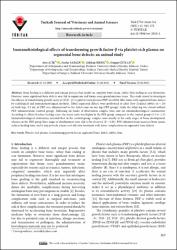Immunohistological effects of transforming growth factor-beta via platelet-rich plasma on segmental bone defects: an animal study

Göster/
Erişim
info:eu-repo/semantics/openAccessAttribution 3.0 United Stateshttp://creativecommons.org/licenses/by/3.0/us/Tarih
2021Üst veri
Tüm öğe kaydını gösterÖzet
Bone healing is a different and unique process that results in complete bone tissue, rather than ending in scar formation.
However, more significant bone defects may fail to regenerate and forms scary granulomatous tissue. This study aimed to investigate
the efficacy of transforming growth factor-β (TGF - β) via platelet rich plasma (PRP) in rabbit tibia bones with segmental bone defects
by radiological and immunohistological methods. Tibial segmental defects were performed to adult New Zealand rabbits (n = 10)
on both legs. 0.5 mL of PRP was administered to the defect zone on one leg (PRP group), while the other leg was closed without
PRP administration (control group). Following six weeks of observation samples were sent for immunohistological examination.
According to Allen’s fracture healing score, the mean score was higher in the PRP group compared to the control group (3.2 vs. 1.3).
Immunohistological evaluations revealed that in the control group, samples were mostly at the early stages of bone development,
whereas in the PRP group, later stages of development were able to be observed (P < 0.05). PRP administration increases bone union,
reduces healing time, and it may provide a more cost-effective treatment with fewer complications in segmental bone defects.
Kaynak
Turkish Journal of Veterinary & Animal SciencesCilt
45Sayı
2Koleksiyonlar
Aşağıdaki lisans dosyası bu öğe ile ilişkilidir:


















